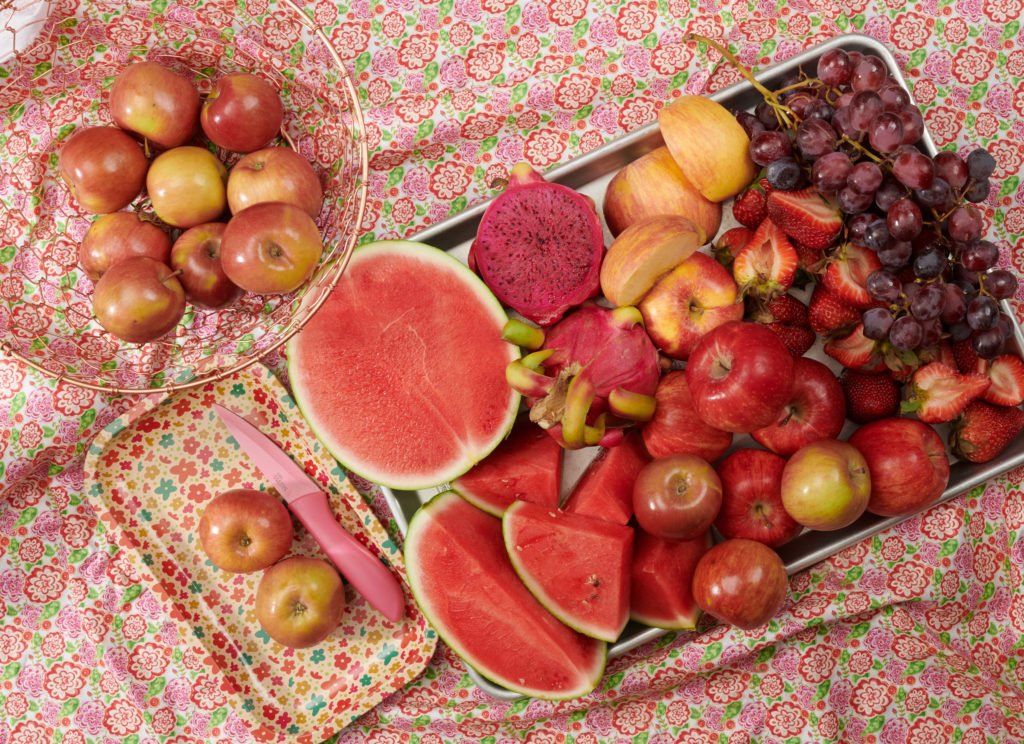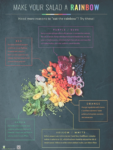Eating in Color: Red
We all know the science. An eating pattern that's rich in fruits and vegetables is great for your health. But people often need a variety of ways to actually incorporate fruits and vegetables into an eating pattern, especially if any of these foods had been inaccessible before or are otherwise new to them. That's why I've created this series: Eating in Color!Eating in Color shines a spotlight on healthful fruits and vegetables by discussing the health benefits of each color of fruits and vegetables, then exploring a particular fruit and vegetable from each color group. So, today, we're going to start with red.Red fruits and vegetables are generally rich sources of vitamin C, folate, and potassium. We all know vitamin C is good for the immune system, but did you know that it's also vital for promoting healthy teeth and gums, helping the body absorb iron, and aiding wound healing? Folate can help reduce cancer risk, reduce homocysteine levels and thus lower the risk of stroke and heart disease, and of course is vital for the development of a healthy baby. Finally, MyPlate reveals that "Diets rich in potassium may help to maintain healthy blood pressure." The Dietary Guidelines for Americans build on this assertion, explaining, "Dietary potassium can lower blood pressure by blunting the adverse effects of sodium on blood pressure. Other possible benefits of an eating pattern rich in potassium include a reduced risk of developing kidney stones and decreased bone loss."Red fruits and vegetables also tend to have a lot of phytonutrients like lycopene and other carotenoids. These fuel antioxidant activity, which is great news for health!
That's why I've created this series: Eating in Color!Eating in Color shines a spotlight on healthful fruits and vegetables by discussing the health benefits of each color of fruits and vegetables, then exploring a particular fruit and vegetable from each color group. So, today, we're going to start with red.Red fruits and vegetables are generally rich sources of vitamin C, folate, and potassium. We all know vitamin C is good for the immune system, but did you know that it's also vital for promoting healthy teeth and gums, helping the body absorb iron, and aiding wound healing? Folate can help reduce cancer risk, reduce homocysteine levels and thus lower the risk of stroke and heart disease, and of course is vital for the development of a healthy baby. Finally, MyPlate reveals that "Diets rich in potassium may help to maintain healthy blood pressure." The Dietary Guidelines for Americans build on this assertion, explaining, "Dietary potassium can lower blood pressure by blunting the adverse effects of sodium on blood pressure. Other possible benefits of an eating pattern rich in potassium include a reduced risk of developing kidney stones and decreased bone loss."Red fruits and vegetables also tend to have a lot of phytonutrients like lycopene and other carotenoids. These fuel antioxidant activity, which is great news for health! Now that we've explored the health benefits of red fruits and vegetables in general, let's take a look at a specific red fruit, the strawberry.Strawberries are loaded with all the nutrients and phytonutrients we explored above, and they're delicious too! When your clients shop for strawberries, they should look for options that are a deep red color, with no bruises or hints of mold. Strawberries should be stored in the refrigerator and washed just before eating.
Now that we've explored the health benefits of red fruits and vegetables in general, let's take a look at a specific red fruit, the strawberry.Strawberries are loaded with all the nutrients and phytonutrients we explored above, and they're delicious too! When your clients shop for strawberries, they should look for options that are a deep red color, with no bruises or hints of mold. Strawberries should be stored in the refrigerator and washed just before eating. (It's worth noting that strawberries are #1 on the dirty dozen list of fruits and vegetables with extreme pesticide exposure, so be sure to wash them thoroughly and consider getting organic strawberries if your budget can support it).
(It's worth noting that strawberries are #1 on the dirty dozen list of fruits and vegetables with extreme pesticide exposure, so be sure to wash them thoroughly and consider getting organic strawberries if your budget can support it). When it comes to eating strawberries, the possibilities are endless! You can eat them plain and unsliced, or incorporate them into a fun fruit salad or berry smoothie. I like to top my peanut butter toast with fresh sliced strawberries, or dip strawberries in chocolate for a beautiful dessert.Of course, the recipe archive has loads of fantastic strawberry recipes. Here are 5 of my favorites...
When it comes to eating strawberries, the possibilities are endless! You can eat them plain and unsliced, or incorporate them into a fun fruit salad or berry smoothie. I like to top my peanut butter toast with fresh sliced strawberries, or dip strawberries in chocolate for a beautiful dessert.Of course, the recipe archive has loads of fantastic strawberry recipes. Here are 5 of my favorites...
- Strawberry Shortcakes
- Strawberry S'Mores
- Strawberry Yogurt Breakfast Treat
- Cinnamon Strawberry Tortillas
- Strawberry Kebabs with Yogurt Dip
Did you know that May is National Strawberry Month?And if strawberries aren't popular with your clients, consider spotlighting one of these other red fruits...
- Cherries
- Red grapes
- Pomegranate
- Red grapefruit
- Raspberries
The Eating in Color series will return tomorrow with a look at a delicious red vegetable. I hope this series will become a valuable tool for your educator toolbox!




